BUSN 20017: A Reflective Essay on Business Communication Concepts
VerifiedAdded on 2023/06/04
|8
|2321
|304
Essay
AI Summary
This essay is a reflective practice on effective business communication, focusing on enhancing capabilities in reflective writing and improving professional career prospects. It identifies and explains the concept of cross-cultural communication, supported by a literature review discussing challenges in intercultural environments. The essay further explores the application of cross-cultural communication and public speaking skills to the author's career aspirations, including an action plan for improvement. The reflection emphasizes the importance of these skills for management positions and team productivity, highlighting the need for continuous development in communication with diverse cultures and public speaking engagements. The student solution is available on Desklib, where students can find past papers and assignments to aid their studies.
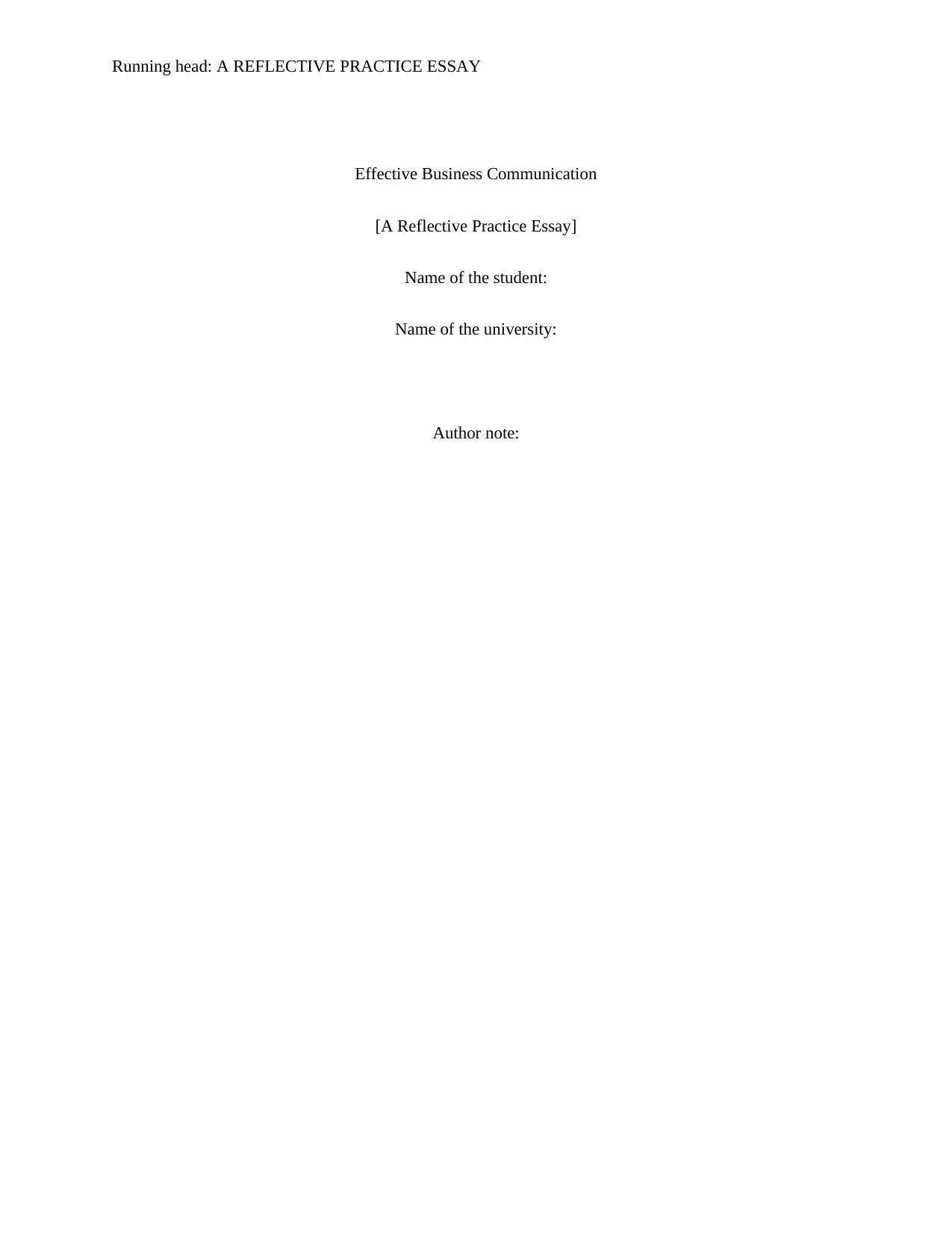
Running head: A REFLECTIVE PRACTICE ESSAY
Effective Business Communication
[A Reflective Practice Essay]
Name of the student:
Name of the university:
Author note:
Effective Business Communication
[A Reflective Practice Essay]
Name of the student:
Name of the university:
Author note:
Paraphrase This Document
Need a fresh take? Get an instant paraphrase of this document with our AI Paraphraser
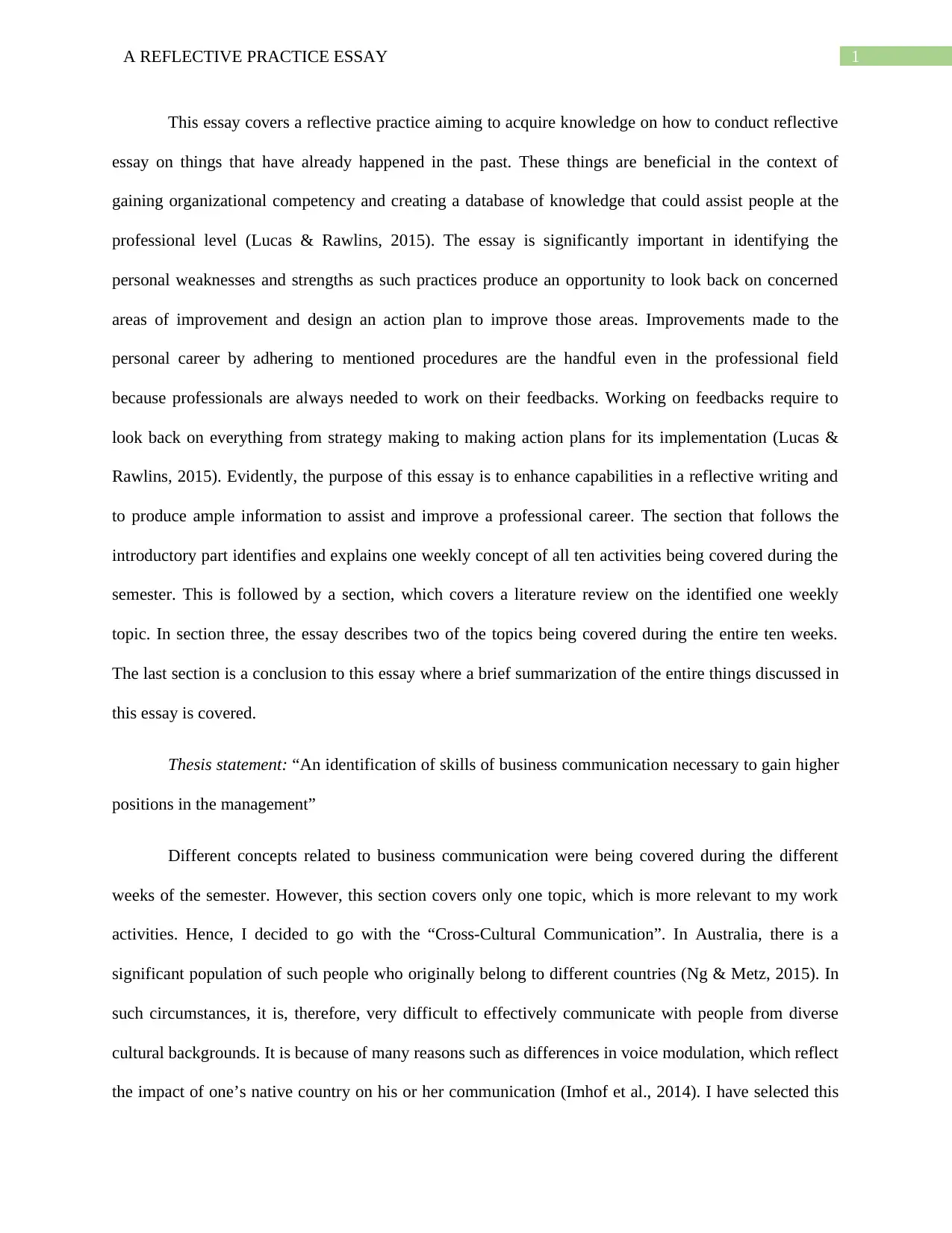
1A REFLECTIVE PRACTICE ESSAY
This essay covers a reflective practice aiming to acquire knowledge on how to conduct reflective
essay on things that have already happened in the past. These things are beneficial in the context of
gaining organizational competency and creating a database of knowledge that could assist people at the
professional level (Lucas & Rawlins, 2015). The essay is significantly important in identifying the
personal weaknesses and strengths as such practices produce an opportunity to look back on concerned
areas of improvement and design an action plan to improve those areas. Improvements made to the
personal career by adhering to mentioned procedures are the handful even in the professional field
because professionals are always needed to work on their feedbacks. Working on feedbacks require to
look back on everything from strategy making to making action plans for its implementation (Lucas &
Rawlins, 2015). Evidently, the purpose of this essay is to enhance capabilities in a reflective writing and
to produce ample information to assist and improve a professional career. The section that follows the
introductory part identifies and explains one weekly concept of all ten activities being covered during the
semester. This is followed by a section, which covers a literature review on the identified one weekly
topic. In section three, the essay describes two of the topics being covered during the entire ten weeks.
The last section is a conclusion to this essay where a brief summarization of the entire things discussed in
this essay is covered.
Thesis statement: “An identification of skills of business communication necessary to gain higher
positions in the management”
Different concepts related to business communication were being covered during the different
weeks of the semester. However, this section covers only one topic, which is more relevant to my work
activities. Hence, I decided to go with the “Cross-Cultural Communication”. In Australia, there is a
significant population of such people who originally belong to different countries (Ng & Metz, 2015). In
such circumstances, it is, therefore, very difficult to effectively communicate with people from diverse
cultural backgrounds. It is because of many reasons such as differences in voice modulation, which reflect
the impact of one’s native country on his or her communication (Imhof et al., 2014). I have selected this
This essay covers a reflective practice aiming to acquire knowledge on how to conduct reflective
essay on things that have already happened in the past. These things are beneficial in the context of
gaining organizational competency and creating a database of knowledge that could assist people at the
professional level (Lucas & Rawlins, 2015). The essay is significantly important in identifying the
personal weaknesses and strengths as such practices produce an opportunity to look back on concerned
areas of improvement and design an action plan to improve those areas. Improvements made to the
personal career by adhering to mentioned procedures are the handful even in the professional field
because professionals are always needed to work on their feedbacks. Working on feedbacks require to
look back on everything from strategy making to making action plans for its implementation (Lucas &
Rawlins, 2015). Evidently, the purpose of this essay is to enhance capabilities in a reflective writing and
to produce ample information to assist and improve a professional career. The section that follows the
introductory part identifies and explains one weekly concept of all ten activities being covered during the
semester. This is followed by a section, which covers a literature review on the identified one weekly
topic. In section three, the essay describes two of the topics being covered during the entire ten weeks.
The last section is a conclusion to this essay where a brief summarization of the entire things discussed in
this essay is covered.
Thesis statement: “An identification of skills of business communication necessary to gain higher
positions in the management”
Different concepts related to business communication were being covered during the different
weeks of the semester. However, this section covers only one topic, which is more relevant to my work
activities. Hence, I decided to go with the “Cross-Cultural Communication”. In Australia, there is a
significant population of such people who originally belong to different countries (Ng & Metz, 2015). In
such circumstances, it is, therefore, very difficult to effectively communicate with people from diverse
cultural backgrounds. It is because of many reasons such as differences in voice modulation, which reflect
the impact of one’s native country on his or her communication (Imhof et al., 2014). I have selected this
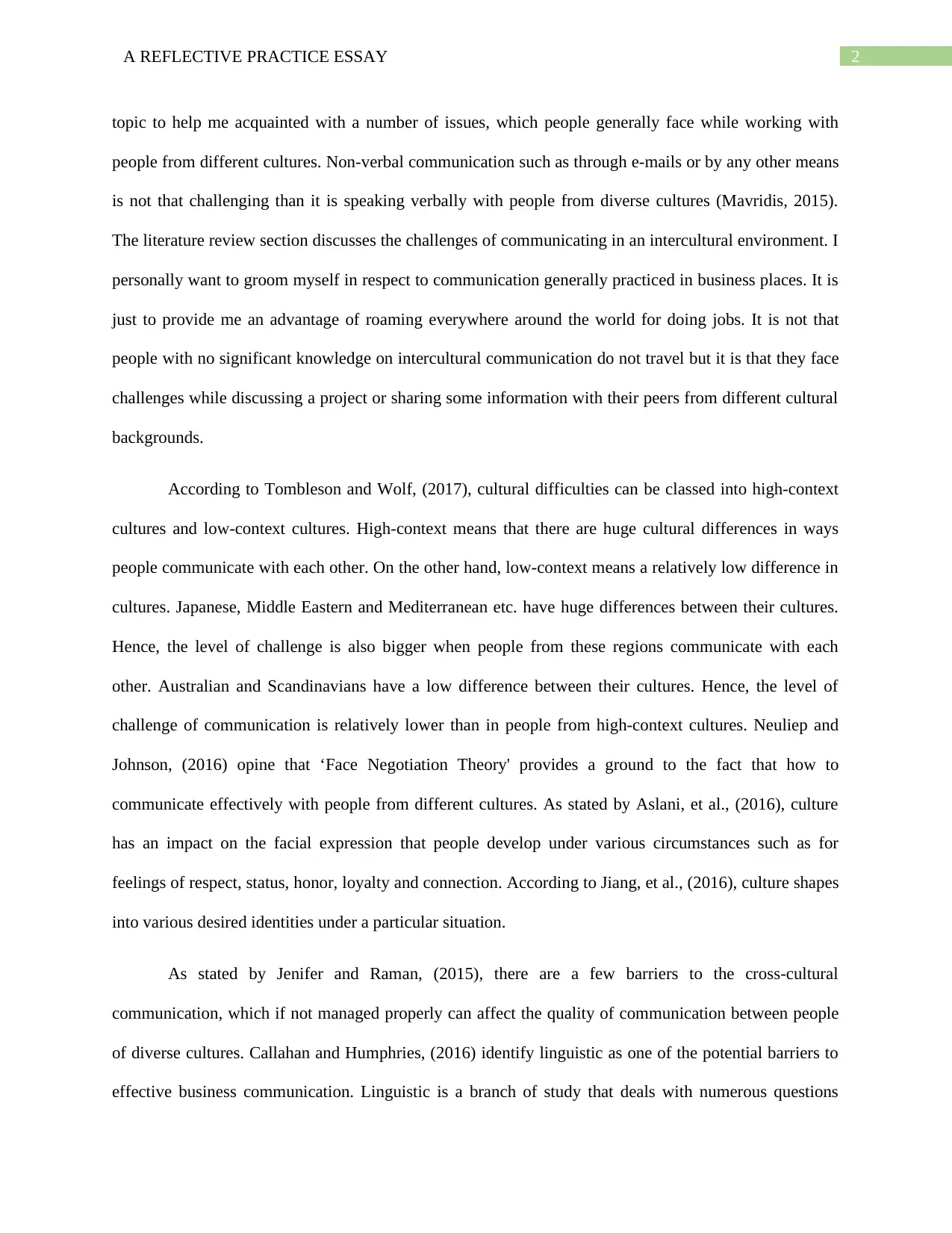
2A REFLECTIVE PRACTICE ESSAY
topic to help me acquainted with a number of issues, which people generally face while working with
people from different cultures. Non-verbal communication such as through e-mails or by any other means
is not that challenging than it is speaking verbally with people from diverse cultures (Mavridis, 2015).
The literature review section discusses the challenges of communicating in an intercultural environment. I
personally want to groom myself in respect to communication generally practiced in business places. It is
just to provide me an advantage of roaming everywhere around the world for doing jobs. It is not that
people with no significant knowledge on intercultural communication do not travel but it is that they face
challenges while discussing a project or sharing some information with their peers from different cultural
backgrounds.
According to Tombleson and Wolf, (2017), cultural difficulties can be classed into high-context
cultures and low-context cultures. High-context means that there are huge cultural differences in ways
people communicate with each other. On the other hand, low-context means a relatively low difference in
cultures. Japanese, Middle Eastern and Mediterranean etc. have huge differences between their cultures.
Hence, the level of challenge is also bigger when people from these regions communicate with each
other. Australian and Scandinavians have a low difference between their cultures. Hence, the level of
challenge of communication is relatively lower than in people from high-context cultures. Neuliep and
Johnson, (2016) opine that ‘Face Negotiation Theory' provides a ground to the fact that how to
communicate effectively with people from different cultures. As stated by Aslani, et al., (2016), culture
has an impact on the facial expression that people develop under various circumstances such as for
feelings of respect, status, honor, loyalty and connection. According to Jiang, et al., (2016), culture shapes
into various desired identities under a particular situation.
As stated by Jenifer and Raman, (2015), there are a few barriers to the cross-cultural
communication, which if not managed properly can affect the quality of communication between people
of diverse cultures. Callahan and Humphries, (2016) identify linguistic as one of the potential barriers to
effective business communication. Linguistic is a branch of study that deals with numerous questions
topic to help me acquainted with a number of issues, which people generally face while working with
people from different cultures. Non-verbal communication such as through e-mails or by any other means
is not that challenging than it is speaking verbally with people from diverse cultures (Mavridis, 2015).
The literature review section discusses the challenges of communicating in an intercultural environment. I
personally want to groom myself in respect to communication generally practiced in business places. It is
just to provide me an advantage of roaming everywhere around the world for doing jobs. It is not that
people with no significant knowledge on intercultural communication do not travel but it is that they face
challenges while discussing a project or sharing some information with their peers from different cultural
backgrounds.
According to Tombleson and Wolf, (2017), cultural difficulties can be classed into high-context
cultures and low-context cultures. High-context means that there are huge cultural differences in ways
people communicate with each other. On the other hand, low-context means a relatively low difference in
cultures. Japanese, Middle Eastern and Mediterranean etc. have huge differences between their cultures.
Hence, the level of challenge is also bigger when people from these regions communicate with each
other. Australian and Scandinavians have a low difference between their cultures. Hence, the level of
challenge of communication is relatively lower than in people from high-context cultures. Neuliep and
Johnson, (2016) opine that ‘Face Negotiation Theory' provides a ground to the fact that how to
communicate effectively with people from different cultures. As stated by Aslani, et al., (2016), culture
has an impact on the facial expression that people develop under various circumstances such as for
feelings of respect, status, honor, loyalty and connection. According to Jiang, et al., (2016), culture shapes
into various desired identities under a particular situation.
As stated by Jenifer and Raman, (2015), there are a few barriers to the cross-cultural
communication, which if not managed properly can affect the quality of communication between people
of diverse cultures. Callahan and Humphries, (2016) identify linguistic as one of the potential barriers to
effective business communication. Linguistic is a branch of study that deals with numerous questions
⊘ This is a preview!⊘
Do you want full access?
Subscribe today to unlock all pages.

Trusted by 1+ million students worldwide
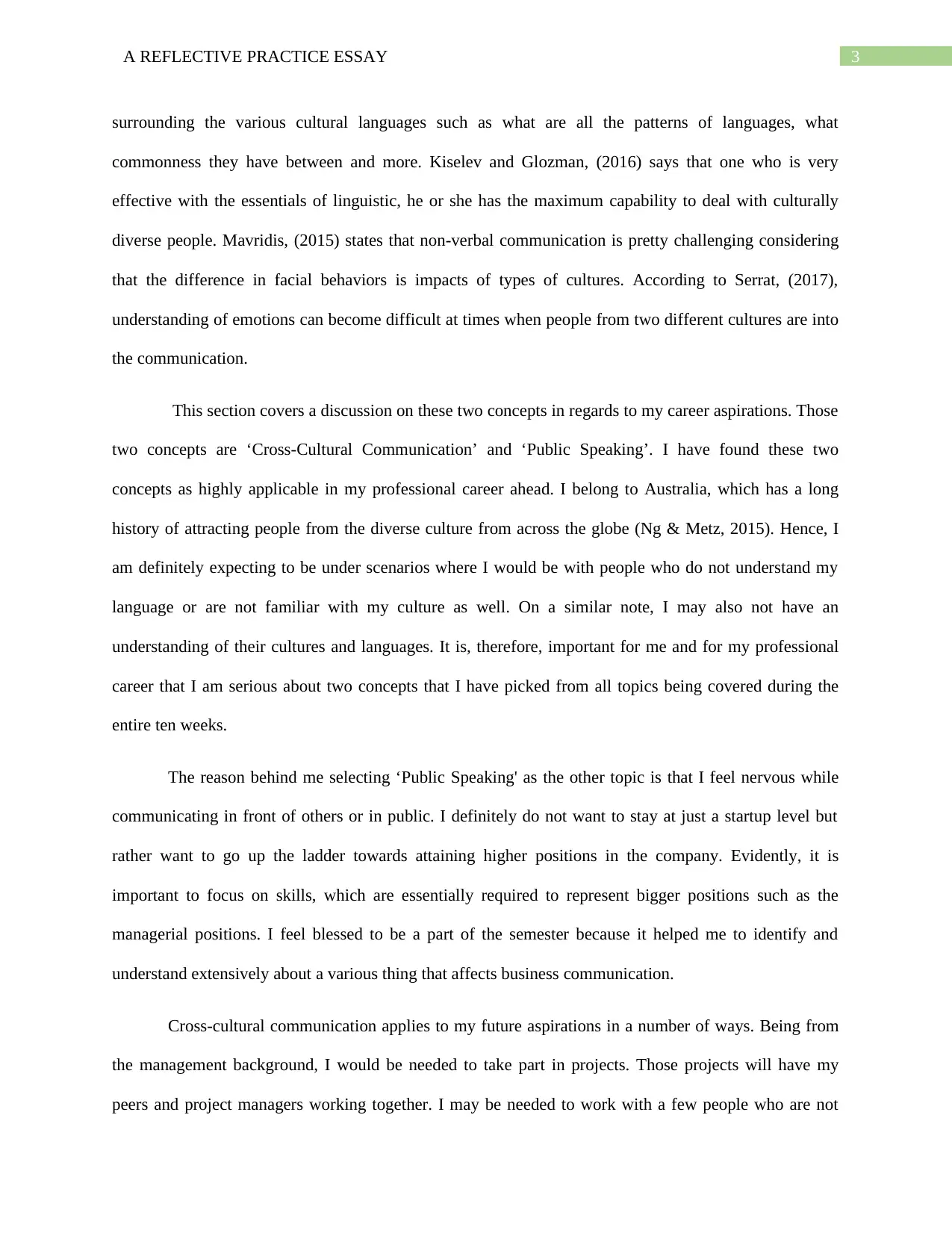
3A REFLECTIVE PRACTICE ESSAY
surrounding the various cultural languages such as what are all the patterns of languages, what
commonness they have between and more. Kiselev and Glozman, (2016) says that one who is very
effective with the essentials of linguistic, he or she has the maximum capability to deal with culturally
diverse people. Mavridis, (2015) states that non-verbal communication is pretty challenging considering
that the difference in facial behaviors is impacts of types of cultures. According to Serrat, (2017),
understanding of emotions can become difficult at times when people from two different cultures are into
the communication.
This section covers a discussion on these two concepts in regards to my career aspirations. Those
two concepts are ‘Cross-Cultural Communication’ and ‘Public Speaking’. I have found these two
concepts as highly applicable in my professional career ahead. I belong to Australia, which has a long
history of attracting people from the diverse culture from across the globe (Ng & Metz, 2015). Hence, I
am definitely expecting to be under scenarios where I would be with people who do not understand my
language or are not familiar with my culture as well. On a similar note, I may also not have an
understanding of their cultures and languages. It is, therefore, important for me and for my professional
career that I am serious about two concepts that I have picked from all topics being covered during the
entire ten weeks.
The reason behind me selecting ‘Public Speaking' as the other topic is that I feel nervous while
communicating in front of others or in public. I definitely do not want to stay at just a startup level but
rather want to go up the ladder towards attaining higher positions in the company. Evidently, it is
important to focus on skills, which are essentially required to represent bigger positions such as the
managerial positions. I feel blessed to be a part of the semester because it helped me to identify and
understand extensively about a various thing that affects business communication.
Cross-cultural communication applies to my future aspirations in a number of ways. Being from
the management background, I would be needed to take part in projects. Those projects will have my
peers and project managers working together. I may be needed to work with a few people who are not
surrounding the various cultural languages such as what are all the patterns of languages, what
commonness they have between and more. Kiselev and Glozman, (2016) says that one who is very
effective with the essentials of linguistic, he or she has the maximum capability to deal with culturally
diverse people. Mavridis, (2015) states that non-verbal communication is pretty challenging considering
that the difference in facial behaviors is impacts of types of cultures. According to Serrat, (2017),
understanding of emotions can become difficult at times when people from two different cultures are into
the communication.
This section covers a discussion on these two concepts in regards to my career aspirations. Those
two concepts are ‘Cross-Cultural Communication’ and ‘Public Speaking’. I have found these two
concepts as highly applicable in my professional career ahead. I belong to Australia, which has a long
history of attracting people from the diverse culture from across the globe (Ng & Metz, 2015). Hence, I
am definitely expecting to be under scenarios where I would be with people who do not understand my
language or are not familiar with my culture as well. On a similar note, I may also not have an
understanding of their cultures and languages. It is, therefore, important for me and for my professional
career that I am serious about two concepts that I have picked from all topics being covered during the
entire ten weeks.
The reason behind me selecting ‘Public Speaking' as the other topic is that I feel nervous while
communicating in front of others or in public. I definitely do not want to stay at just a startup level but
rather want to go up the ladder towards attaining higher positions in the company. Evidently, it is
important to focus on skills, which are essentially required to represent bigger positions such as the
managerial positions. I feel blessed to be a part of the semester because it helped me to identify and
understand extensively about a various thing that affects business communication.
Cross-cultural communication applies to my future aspirations in a number of ways. Being from
the management background, I would be needed to take part in projects. Those projects will have my
peers and project managers working together. I may be needed to work with a few people who are not
Paraphrase This Document
Need a fresh take? Get an instant paraphrase of this document with our AI Paraphraser
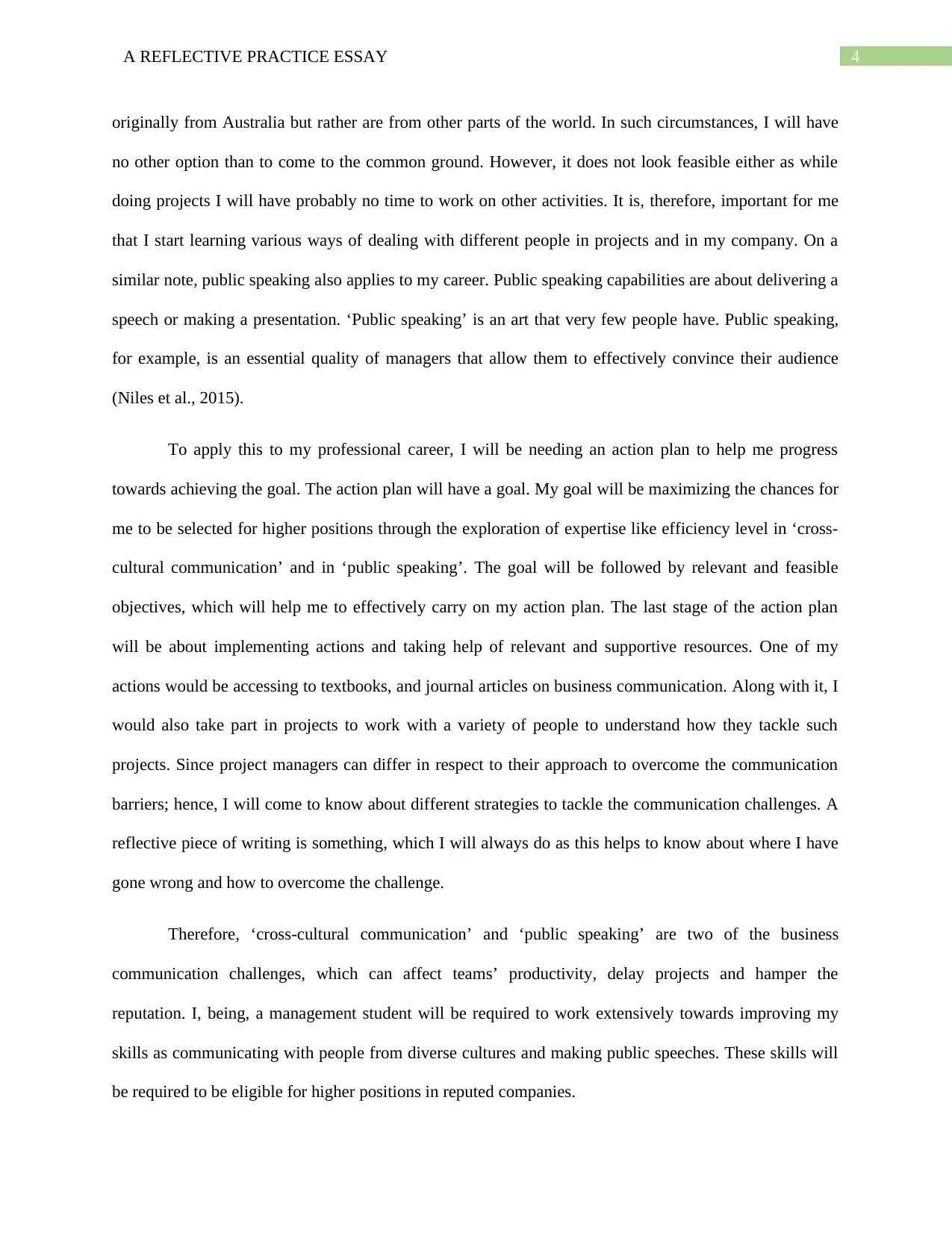
4A REFLECTIVE PRACTICE ESSAY
originally from Australia but rather are from other parts of the world. In such circumstances, I will have
no other option than to come to the common ground. However, it does not look feasible either as while
doing projects I will have probably no time to work on other activities. It is, therefore, important for me
that I start learning various ways of dealing with different people in projects and in my company. On a
similar note, public speaking also applies to my career. Public speaking capabilities are about delivering a
speech or making a presentation. ‘Public speaking’ is an art that very few people have. Public speaking,
for example, is an essential quality of managers that allow them to effectively convince their audience
(Niles et al., 2015).
To apply this to my professional career, I will be needing an action plan to help me progress
towards achieving the goal. The action plan will have a goal. My goal will be maximizing the chances for
me to be selected for higher positions through the exploration of expertise like efficiency level in ‘cross-
cultural communication’ and in ‘public speaking’. The goal will be followed by relevant and feasible
objectives, which will help me to effectively carry on my action plan. The last stage of the action plan
will be about implementing actions and taking help of relevant and supportive resources. One of my
actions would be accessing to textbooks, and journal articles on business communication. Along with it, I
would also take part in projects to work with a variety of people to understand how they tackle such
projects. Since project managers can differ in respect to their approach to overcome the communication
barriers; hence, I will come to know about different strategies to tackle the communication challenges. A
reflective piece of writing is something, which I will always do as this helps to know about where I have
gone wrong and how to overcome the challenge.
Therefore, ‘cross-cultural communication’ and ‘public speaking’ are two of the business
communication challenges, which can affect teams’ productivity, delay projects and hamper the
reputation. I, being, a management student will be required to work extensively towards improving my
skills as communicating with people from diverse cultures and making public speeches. These skills will
be required to be eligible for higher positions in reputed companies.
originally from Australia but rather are from other parts of the world. In such circumstances, I will have
no other option than to come to the common ground. However, it does not look feasible either as while
doing projects I will have probably no time to work on other activities. It is, therefore, important for me
that I start learning various ways of dealing with different people in projects and in my company. On a
similar note, public speaking also applies to my career. Public speaking capabilities are about delivering a
speech or making a presentation. ‘Public speaking’ is an art that very few people have. Public speaking,
for example, is an essential quality of managers that allow them to effectively convince their audience
(Niles et al., 2015).
To apply this to my professional career, I will be needing an action plan to help me progress
towards achieving the goal. The action plan will have a goal. My goal will be maximizing the chances for
me to be selected for higher positions through the exploration of expertise like efficiency level in ‘cross-
cultural communication’ and in ‘public speaking’. The goal will be followed by relevant and feasible
objectives, which will help me to effectively carry on my action plan. The last stage of the action plan
will be about implementing actions and taking help of relevant and supportive resources. One of my
actions would be accessing to textbooks, and journal articles on business communication. Along with it, I
would also take part in projects to work with a variety of people to understand how they tackle such
projects. Since project managers can differ in respect to their approach to overcome the communication
barriers; hence, I will come to know about different strategies to tackle the communication challenges. A
reflective piece of writing is something, which I will always do as this helps to know about where I have
gone wrong and how to overcome the challenge.
Therefore, ‘cross-cultural communication’ and ‘public speaking’ are two of the business
communication challenges, which can affect teams’ productivity, delay projects and hamper the
reputation. I, being, a management student will be required to work extensively towards improving my
skills as communicating with people from diverse cultures and making public speeches. These skills will
be required to be eligible for higher positions in reputed companies.

5A REFLECTIVE PRACTICE ESSAY
⊘ This is a preview!⊘
Do you want full access?
Subscribe today to unlock all pages.

Trusted by 1+ million students worldwide
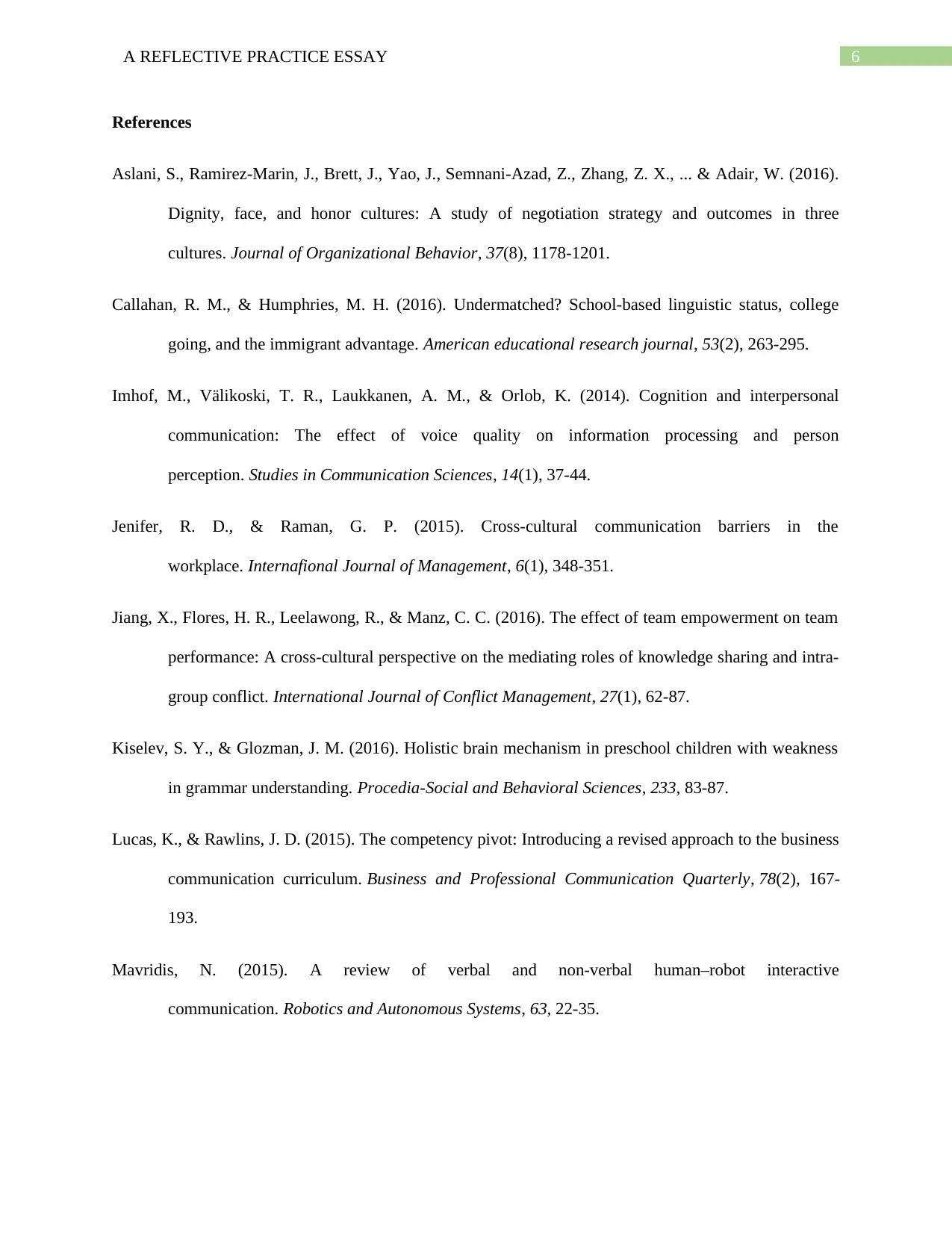
6A REFLECTIVE PRACTICE ESSAY
References
Aslani, S., Ramirez‐Marin, J., Brett, J., Yao, J., Semnani‐Azad, Z., Zhang, Z. X., ... & Adair, W. (2016).
Dignity, face, and honor cultures: A study of negotiation strategy and outcomes in three
cultures. Journal of Organizational Behavior, 37(8), 1178-1201.
Callahan, R. M., & Humphries, M. H. (2016). Undermatched? School-based linguistic status, college
going, and the immigrant advantage. American educational research journal, 53(2), 263-295.
Imhof, M., Välikoski, T. R., Laukkanen, A. M., & Orlob, K. (2014). Cognition and interpersonal
communication: The effect of voice quality on information processing and person
perception. Studies in Communication Sciences, 14(1), 37-44.
Jenifer, R. D., & Raman, G. P. (2015). Cross-cultural communication barriers in the
workplace. Internafional Journal of Management, 6(1), 348-351.
Jiang, X., Flores, H. R., Leelawong, R., & Manz, C. C. (2016). The effect of team empowerment on team
performance: A cross-cultural perspective on the mediating roles of knowledge sharing and intra-
group conflict. International Journal of Conflict Management, 27(1), 62-87.
Kiselev, S. Y., & Glozman, J. M. (2016). Holistic brain mechanism in preschool children with weakness
in grammar understanding. Procedia-Social and Behavioral Sciences, 233, 83-87.
Lucas, K., & Rawlins, J. D. (2015). The competency pivot: Introducing a revised approach to the business
communication curriculum. Business and Professional Communication Quarterly, 78(2), 167-
193.
Mavridis, N. (2015). A review of verbal and non-verbal human–robot interactive
communication. Robotics and Autonomous Systems, 63, 22-35.
References
Aslani, S., Ramirez‐Marin, J., Brett, J., Yao, J., Semnani‐Azad, Z., Zhang, Z. X., ... & Adair, W. (2016).
Dignity, face, and honor cultures: A study of negotiation strategy and outcomes in three
cultures. Journal of Organizational Behavior, 37(8), 1178-1201.
Callahan, R. M., & Humphries, M. H. (2016). Undermatched? School-based linguistic status, college
going, and the immigrant advantage. American educational research journal, 53(2), 263-295.
Imhof, M., Välikoski, T. R., Laukkanen, A. M., & Orlob, K. (2014). Cognition and interpersonal
communication: The effect of voice quality on information processing and person
perception. Studies in Communication Sciences, 14(1), 37-44.
Jenifer, R. D., & Raman, G. P. (2015). Cross-cultural communication barriers in the
workplace. Internafional Journal of Management, 6(1), 348-351.
Jiang, X., Flores, H. R., Leelawong, R., & Manz, C. C. (2016). The effect of team empowerment on team
performance: A cross-cultural perspective on the mediating roles of knowledge sharing and intra-
group conflict. International Journal of Conflict Management, 27(1), 62-87.
Kiselev, S. Y., & Glozman, J. M. (2016). Holistic brain mechanism in preschool children with weakness
in grammar understanding. Procedia-Social and Behavioral Sciences, 233, 83-87.
Lucas, K., & Rawlins, J. D. (2015). The competency pivot: Introducing a revised approach to the business
communication curriculum. Business and Professional Communication Quarterly, 78(2), 167-
193.
Mavridis, N. (2015). A review of verbal and non-verbal human–robot interactive
communication. Robotics and Autonomous Systems, 63, 22-35.
Paraphrase This Document
Need a fresh take? Get an instant paraphrase of this document with our AI Paraphraser
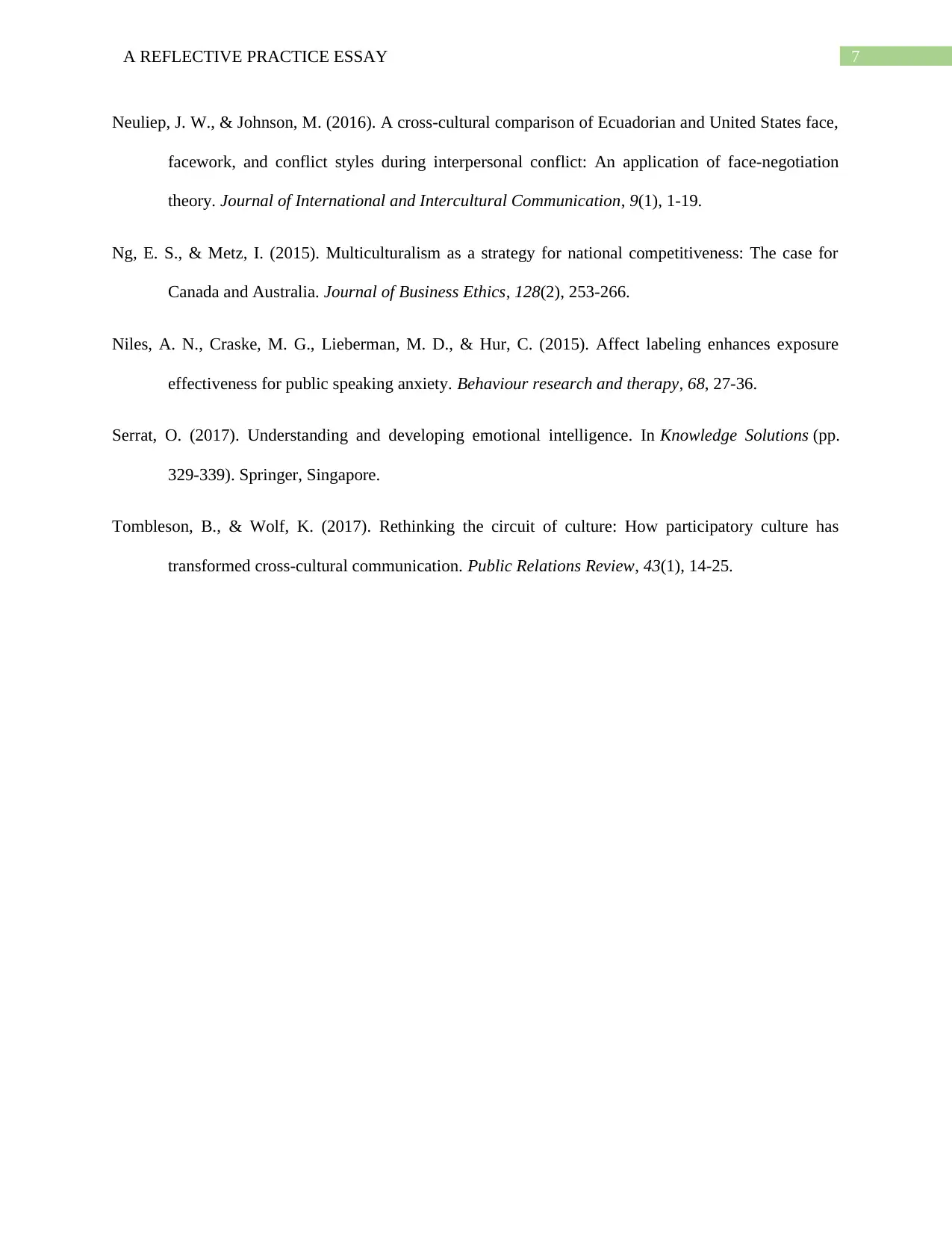
7A REFLECTIVE PRACTICE ESSAY
Neuliep, J. W., & Johnson, M. (2016). A cross-cultural comparison of Ecuadorian and United States face,
facework, and conflict styles during interpersonal conflict: An application of face-negotiation
theory. Journal of International and Intercultural Communication, 9(1), 1-19.
Ng, E. S., & Metz, I. (2015). Multiculturalism as a strategy for national competitiveness: The case for
Canada and Australia. Journal of Business Ethics, 128(2), 253-266.
Niles, A. N., Craske, M. G., Lieberman, M. D., & Hur, C. (2015). Affect labeling enhances exposure
effectiveness for public speaking anxiety. Behaviour research and therapy, 68, 27-36.
Serrat, O. (2017). Understanding and developing emotional intelligence. In Knowledge Solutions (pp.
329-339). Springer, Singapore.
Tombleson, B., & Wolf, K. (2017). Rethinking the circuit of culture: How participatory culture has
transformed cross-cultural communication. Public Relations Review, 43(1), 14-25.
Neuliep, J. W., & Johnson, M. (2016). A cross-cultural comparison of Ecuadorian and United States face,
facework, and conflict styles during interpersonal conflict: An application of face-negotiation
theory. Journal of International and Intercultural Communication, 9(1), 1-19.
Ng, E. S., & Metz, I. (2015). Multiculturalism as a strategy for national competitiveness: The case for
Canada and Australia. Journal of Business Ethics, 128(2), 253-266.
Niles, A. N., Craske, M. G., Lieberman, M. D., & Hur, C. (2015). Affect labeling enhances exposure
effectiveness for public speaking anxiety. Behaviour research and therapy, 68, 27-36.
Serrat, O. (2017). Understanding and developing emotional intelligence. In Knowledge Solutions (pp.
329-339). Springer, Singapore.
Tombleson, B., & Wolf, K. (2017). Rethinking the circuit of culture: How participatory culture has
transformed cross-cultural communication. Public Relations Review, 43(1), 14-25.
1 out of 8
Related Documents
Your All-in-One AI-Powered Toolkit for Academic Success.
+13062052269
info@desklib.com
Available 24*7 on WhatsApp / Email
![[object Object]](/_next/static/media/star-bottom.7253800d.svg)
Unlock your academic potential
Copyright © 2020–2025 A2Z Services. All Rights Reserved. Developed and managed by ZUCOL.




